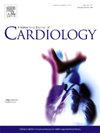心肌桥接和LAD长度与Takotsubo综合征的关系:一项MINOCA横断面研究。
IF 3.2
2区 医学
Q2 CARDIAC & CARDIOVASCULAR SYSTEMS
引用次数: 0
摘要
背景:Takotsubo综合征(TTS)是一种由情绪或身体压力引发的急性心脏疾病,以儿茶酚胺激增和短暂性左心室功能障碍为特征。虽然心肌桥(MB)和左前降支(LAD)长度被认为是影响TTS的因素,但它们在TTS中的作用仍不确定。本研究旨在评估在特征明确的非阻塞性冠状动脉心肌梗死(MINOCA)队列中,TTS是否与MB或LAD长度相关。方法:我们分析了183名来自前瞻性斯德哥尔摩心肌梗死伴有正常冠状动脉(SMINC) 1和2研究的参与者,这些研究的重点是MINOCA。所有参与者都接受了冠状动脉计算机断层血管造影(CCTA)和有创冠状动脉血管造影(ICA)。用CCTA评估MB,用ICA测量LAD长度。将TTS患者(n = 60)与没有TTS的MINOCA对照组(n = 123)进行比较。结果:37 %的TTS患者和42 %的对照组存在MB,没有观察到显著的关联(p = 0.523),包括部分或完全包膜分层。各组间LAD长度无显著差异(p = 0.088)。结论:本研究发现MB或LAD长度与TTS的发生无显著相关性。这些结果表明,LAD的结构变化不太可能在TTS的发展中起主要作用,强调了探索冠状动脉解剖之外的其他病理生理机制的重要性。本文章由计算机程序翻译,如有差异,请以英文原文为准。
Association of myocardial bridging and LAD length with Takotsubo syndrome: A MINOCA cross-sectional study
Background
Takotsubo syndrome (TTS) is an acute cardiac condition triggered by emotional or physical stress, characterized by a catecholamine surge and transient left ventricular dysfunction.
Although myocardial bridging (MB) and left anterior descending artery (LAD) length have been proposed as contributing factors, their roles in TTS remain uncertain. This study aimed to assess whether TTS is associated with MB or LAD length in a well-characterized myocardial infarction with non-obstructive coronary arteries (MINOCA) cohort.
Methods
We analyzed 183 participants from the prospective Stockholm Myocardial Infarction with Normal Coronaries (SMINC) 1 and 2 studies, which focused on MINOCA. All participants underwent coronary computed tomography angiography (CCTA) and invasive coronary angiography (ICA). MB was assessed with CCTA, and LAD length was measured using ICA. TTS patients (n = 60) were compared with MINOCA controls without TTS (n = 123).
Results
MB was present in 37 % of TTS patients and 42 % of controls, with no significant association observed (p = 0.523), including when stratified by partial or full encasement. LAD length did not differ significantly between groups (p = 0.088).
Conclusion
This study found no significant association between MB or LAD length and the occurrence of TTS. These results suggest that structural variations in the LAD are unlikely to play a major role in the development of TTS, underscoring the importance of exploring alternative pathophysiological mechanisms beyond coronary anatomy.
求助全文
通过发布文献求助,成功后即可免费获取论文全文。
去求助
来源期刊

International journal of cardiology
医学-心血管系统
CiteScore
6.80
自引率
5.70%
发文量
758
审稿时长
44 days
期刊介绍:
The International Journal of Cardiology is devoted to cardiology in the broadest sense. Both basic research and clinical papers can be submitted. The journal serves the interest of both practicing clinicians and researchers.
In addition to original papers, we are launching a range of new manuscript types, including Consensus and Position Papers, Systematic Reviews, Meta-analyses, and Short communications. Case reports are no longer acceptable. Controversial techniques, issues on health policy and social medicine are discussed and serve as useful tools for encouraging debate.
 求助内容:
求助内容: 应助结果提醒方式:
应助结果提醒方式:


